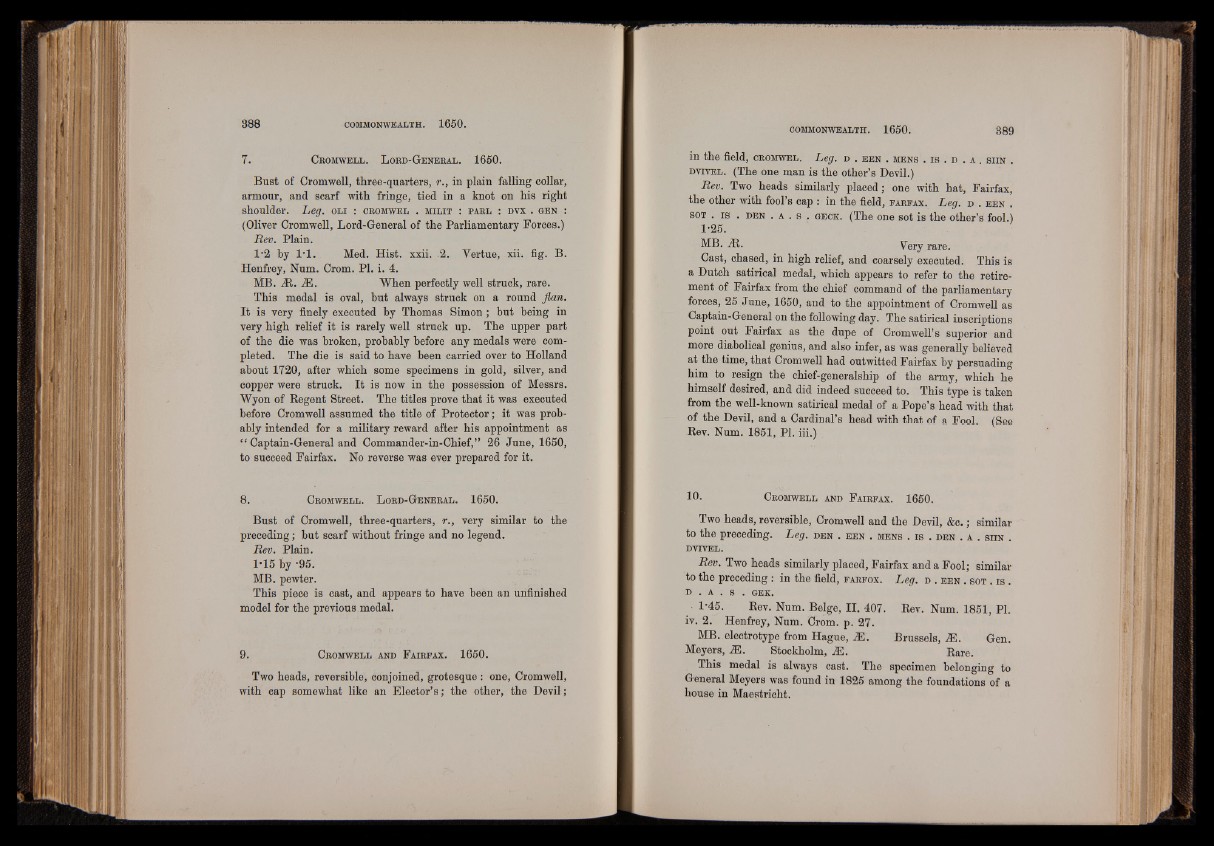
7 . C r o m w e l l . L o rd -G e n e r a l . 1 6 5 0 .
Bust of Cromwell, three-quarters, r., in plain falling collar,
armour, and scarf with fringe, tied in a knot on his right
shoulder. Leg. o l i : c rom w e l . m il it : pa r l : dvx . g e n :
(Oliver Cromwell, Lord-General of the Parliamentary Forces.)
Rev. Plain.
1*2 by IT . Med. Hist. xxii. 2. Yertue, xii. fig. B.
Henfrey, Num. Crom. PI. i. 4.
MB. jit. M. When perfectly well struck, rare.
This medal is oval, but always struck on a round flan.
It is very finely executed by Thomas Simon; but being in
very high relief it is rarely well struck up. The upper part
of the die was broken, probably before any medals were completed.
The die is said to have been carried over to Holland
about 1720, after which some specimens in gold, silver, and
copper were struck. It is now in the possession of Messrs.
Wyon of Begent Street. The titles prove that it was executed
before Cromwell assumed the title of Protector ; it was probably
intended for a military reward after his appointment as
“ Captain-General and Commander-in-Chief,” 26 June, 1650,
to succeed Fairfax. No reverse was ever prepared for it.
8 . C r o m w e l l . L ord -G e n e r a l . 1650.
Bust of Cromwell, three-quarters, r., very similar to the
preceding; but scarf without fringe and no legend.
Rev. Plain.
1*15 by -95.
MB. pewter.
This piece is cast, and appears to have been an unfinished
model for the previous medal.
9. C r om w e l l and F a ir fa x . 1650.
Two heads, reversible, conjoined, grotesque : one, Cromwell,
with cap somewhat like an Elector’s ; the other, the Devil;
in the field, c r om w e l . Leg. d . e e n . m en s . i s . d . a . s i in .
dvtvel. (The one man is the other’s Devil.)
Rev. Two heads similarly placed; one with hat, Fairfax,
the other with fool’s cap : in the field, fa r fa x . Leg. d . e e n .
sot . is . d e n . a . s , g e c k . (The one sot is the other’s fool.)
1-25.
MB. M. Very rare.
Cast, chased, in high relief, and coarsely executed. This is
a Dutch satirical medal, which appears to refer to the retirement
of Fairfax from the chief command of the parliamentary
forces, 25 June, 1650, and to the appointment of Cromwell as
Captain-General on the following day. The satirical inscriptions
point out Fairfax as the dupe of Cromwell’s superior and
more diabolical genius, and also infer, as was generally believed
at the time, that Cromwell had outwitted Fairfax by persuading
him to resign the chief-generalship of the army, which he
himself desired, and did indeed succeed to. This type is taken
from the well-known satirical medal of a Pope’s head with that
of the Devil, and a Cardinal’s head with that of a Fool. (See
Rev. Num. 1851, PI. iii.)
10. C r om w e l l and F a ir fa x . 1650.
Two heads, reversible, Cromwell and the Devil, &c.; similar
to the preceding. Leg. d e n . e e n . m en s . is . d e n . a . s i in .
DVTVEL.
Rev. Two heads similarly placed, Fairfax and a Fool; similar
to the preceding: in the field, fa r fo x . Leg. d . e e n . sot . i s .
D . A . S . GEE.
1-45. Rev. Num. Beige, II. 407. Rev. Num. 1851, PI.
iv. 2. Henfrey, Num. Crom. p. 27.
MB. electrotype from Hague, .ffi. Brussels, M. Gen.
Meyers, M. Stockholm, iE. Rare.
This medal is always cast. The specimen belonging to
General Meyers was found in 1825 among the foundations of a
house in Maestricht.